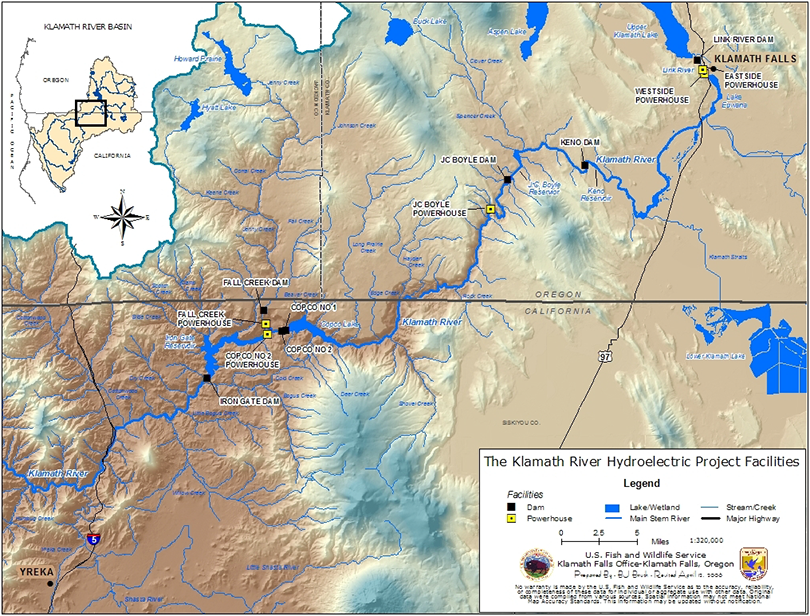Two landmark agreements support removal of four dams on California’s and Oregon’s Klamath River to restore fish runs and water quality while also protecting local water users, the U.S. Department of the Interior (DOI) announced at a 6 April signing ceremony on a bank of the river.
A dam removal agreement, signed by DOI, the Department of Commerce, dam owner PacifiCorps, and the states of California and Oregon, would remove the dams by 2020, according to DOI.
The federal agencies and the states also signed a second agreement with irrigation interests and other parties to help local irrigators avoid any adverse financial and regulatory impacts that could be associated with the return of fish runs to the Upper Klamath Basin.
Dam removal would open up hundreds of kilometers of the river for fish spawning and rearing habitat. The Klamath historically ranked as the third most productive watershed for salmon and steelhead on the West Coast, according to Trout Unlimited, a party to the dam removal agreement.
Although a broad range of local tribes, water users, and other stakeholders support the new agreements, some officials and residents oppose the dam removal plan, saying that the dams provide power for the region and that their removal would pollute the river.
Historic Agreements
“These historical agreements are important initial steps to enable the largest dam removal project in the history of our nation and to provide a road map for long-term restoration and sustainability for tribes, for fisheries, for agriculture, and for water users across the basin,” Interior Secretary Sally Jewell said at the signing ceremony at the mouth of the Klamath River on the Yurok Indian Reservation in Klamath, Calif. She said other measures will be required to restore the river and that many of those efforts require congressional action.
The dam removal agreement will be filed with the U.S. Federal Energy Regulatory Commission, which oversees the operation of many dams in the country, on or about 1 July, according to DOI. The agreement calls for PacifiCorp to transfer its license to operate the dams to a private company, the Klamath River Renewal Corporation, which will oversee dam removal. The pacts build upon previous attempts to restore the river, including a 2010 Klamath Basin Restoration Agreement that expired last December and a 2010 Klamath Hydroelectric Settlement Agreement, which Congress has not yet authorized.
“This is good exercise of humankind correcting some of the mistakes that it’s made in the past.”
California Governor Jerry Brown said the deal is a big step toward “healing” the river. “This is good exercise of humankind correcting some of the mistakes that it’s made in the past,” he said.
The agreement will restore long stretches of salmon spawning habitat and eliminate shallow reservoirs that trap warm water and cause algae blooms, said U.S. Rep. Jared Huffman (D-Calif.), who represents part of the lower Klamath River Basin.

Opposition to the Plans
Rep. Doug LaMalfa (R-Calif.) opposes the plan, stating that Klamath Basin residents “have been cut out of this process in favor of environmental extremists, bureaucrats in Sacramento and Washington, and a taxpayer bailout for billionaire Warren Buffett.” LaMalfa alluded to ownership of PacifiCorp by Berkshire Hathaway Energy, an international energy holding company primarily owned by Berkshire Hathaway, Inc., of which Buffett is chair and CEO.
“This is just another example of manipulating science for a predetermined outcome.”
About two thirds of the 423-kilometer-long river flows through Siskiyou County, Calif., where Grace Bennett chairs the county’s board of supervisors. She told Eos that the agreements are “a tragedy” for county residents. Agencies supporting dam removal “have not considered the effects this will have on the health of this entire river system and the people that live along its banks,” she said. “This is just another example of manipulating science for a predetermined outcome,” she added. However, at the signing ceremony, DOI’s Jewell described the scientific and engineering analyses supporting the plan as “rigorous.”
Siskiyou County resident Liz Bowen, a founding supporter of the grassroots group Scott Valley Protect Our Water, told Eos that the contaminated sediment released by dam demolition would destroy water quality, fish habitat, and the surrounding environment. She added that people in the county are “adamant the well-maintained hydroelectric dams must be saved, as they provide stability to an unstable Klamath River, power to 70,000 area residents, and water flow security to millions of fish.”
—Randy Showstack, Staff Writer
Citation: Showstack, R. (2016), Controversial pacts aim for dam removals on western U.S. river, Eos, 97, doi:10.1029/2016EO049983. Published on 11 April 2016.
Text © 2016. The authors. CC BY-NC-ND 3.0
Except where otherwise noted, images are subject to copyright. Any reuse without express permission from the copyright owner is prohibited.

